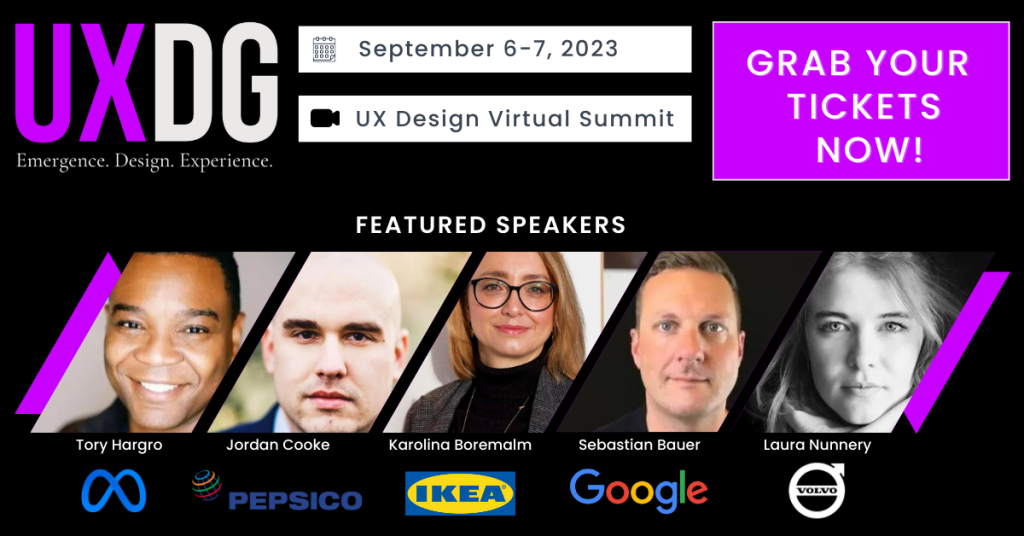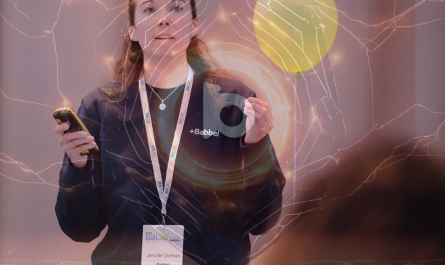Navigating the future of product design: Insights from PepsiCo’s Jordan Cooke
Jordan Cooke is the Product Design Director and Global Head of Design for DTX (Digital Transformation and Experiences) at PepsiCo. Jordan will be joining us at the UXDG Virtual Summit 2023, where he will share his experiences as a product design leader in his organization. As part of our series of interviews, we asked Jordan about the focus of his presentation and his presentation and expectation for UXDG 2023.
UXDG: We extend a warm welcome to you for our 2nd annual UXDG Design Summit. Could you share your reasons for attending and the outcomes you’re hoping for?
 Jordan: I’m always excited about opportunities to connect with others in the design community and share my thoughts and experiences. I expect an engaged and energetic audience. I anticipate a lot of fantastic questions and dialogue. I’m looking forward to meeting others and hearing about what is top of mind for them as fellow design professionals.
Jordan: I’m always excited about opportunities to connect with others in the design community and share my thoughts and experiences. I expect an engaged and energetic audience. I anticipate a lot of fantastic questions and dialogue. I’m looking forward to meeting others and hearing about what is top of mind for them as fellow design professionals.
UXDG: How has UX Design Leadership changed today?
Jordan: The modern design leader needs to be able to find the connective tissue across diverse and complex digital ecosystems and identify opportunities for innovation. They must balance the considerations of the business with the expectations, needs and desires of their team, which seem to be more at odds than ever before. Design leadership is about building relationships across an organization and across all levels, developing a shared vision and aligning practitioners, stakeholders, and users on it.
UXDG: Without giving too much away – what is the core message of your talk and what would you like our delegates to remember?
Jordan: 2023 has been a challenging year for the design community. But with any challenge, there is opportunity. No matter what you’re going through, understand we are going through it together. The landscape of design might be shifting, but the sky is not falling, and the future is still bright.
UXDG: What does design leadership mean to you and what role does design play in the strategy and business?
 Jordan: To me, design leadership distils down to three a’s: adaptability, advocacy, and articulation. Adapting to change, advocating for your team and your experiences, and articulating a shared vision that resonates across your organization. The value design plays in driving successful business outcomes are well documented. In many organizations, this has granted design a seat at the table at the highest level. The challenge has now become using that platform to identify opportunities that live at the confluence of user need and business strategy.
Jordan: To me, design leadership distils down to three a’s: adaptability, advocacy, and articulation. Adapting to change, advocating for your team and your experiences, and articulating a shared vision that resonates across your organization. The value design plays in driving successful business outcomes are well documented. In many organizations, this has granted design a seat at the table at the highest level. The challenge has now become using that platform to identify opportunities that live at the confluence of user need and business strategy.
UXDG: AI is no longer just a buzzword; it has become an integral part of our everyday lives. Does it pose a real threat to the world of Product Design? How can design embrace it, and what impact is it having in your field, especially in the F&B industry?
Jordan: The design discipline has evolved considerably in the 15 or so years that I’ve been a part of it. AI represents the next phase of that evolution. As with any technology, we must develop an understanding of it and then identify opportunities to utilize it to our benefit. I believe that the design community will find ways to use AI to enhance the quality, speed, and impact of our work. But design is a discipline rooted in creativity, individuality, and nuance.
Right now, AI can do a pretty good job of producing output derivative of other things it has absorbed. But ask it to create an original poem, or five minutes of stand-up comedy, or a memorable advertisement for a product, and you will likely be underwhelmed by the product. I believe this is because those activities, like product design, necessitate not only an understanding of the discipline, but a discerning and inspired hand to craft it. In a human, we would call that talent. Can AI replicate natural talent? Early signs suggest not.
AI will certainly help us ideate, automate, and augment our work. But, in my estimation, and until AI proves differently, there will always be a place for talented product designers.
UXDG: Where is UX & Product Design headed? What does the future of the discipline look like?
Jordan: I’m not Nostradamus, and the discipline always surprises me. That’s one of the things I cherish about it. Over the past decade, driven by an interest in framing design more objectively, we’ve witnessed our field incorporate more research, testing, and optimization. Furthermore, the widespread integration of digital experiences into every facet of our lives, combined with the business imperative for speed to market, has resulted in a broad standardization of UX. As a result, many designs have a similar look and feel.
Believing that trends are cyclical, I anticipate a renewed emphasis on exploration and experimentation in the experiences we craft, all with the aim of producing more unique and genuine digital touchpoints. I eagerly await a resurgence of originality, with designs that smartly and intentionally deviate from the ‘standard components’. I’m also keen to see how the next generation of designers, raised with these ‘best practices’ as second nature, will innovate and distinguish their work.










 by
by 


